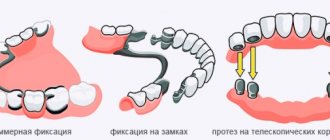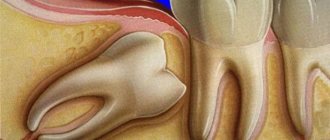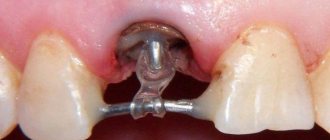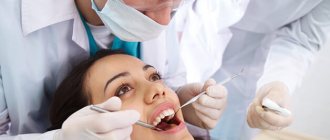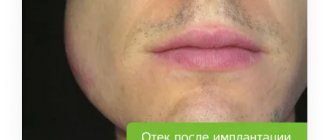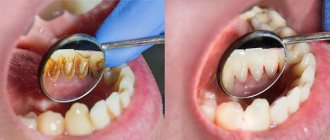Causes of bleeding gums
If you notice your gums are bleeding, before you panic, first consider whether you might:
- mechanically damage the interdental spaces when using floss (dental floss). In this case, it is worth treating the oral cavity with an antiseptic solution of chlorhexidine 2-3 times a day, rinsing with calendula decoction
- replace a regular toothbrush with an electric one. Bleeding is normal the first few times you use an electric toothbrush. This usually goes away completely within 2-3 days. If not, contact your dentist, start rinsing with an antiseptic, and stop using the power brush until you receive further instructions from your doctor.
- Using an oral irrigator incorrectly. Often new owners of such an indispensable device as an irrigator immediately begin to treat the oral cavity with a high-pressure stream of water instead of allowing the tissues to adapt. In this case, it is worth temporarily filling the irrigator container with chlorhexidine, either pure or mixed with water, and cleaning at the minimum power level. Typically, symptoms should completely disappear within a couple of days.
Also, bleeding gums are not a rare occurrence in pregnant women as a result of powerful hormonal changes. During this period, you need to treat your teeth with increased attention and care.
None of the above? Then there is a high probability of an inflammatory process in the tissues. In the early stages, you may notice slight bleeding and slight swelling - signs of gingivitis. Ignoring the symptoms can lead to the development of pain and the onset of suppuration, which will indicate the transition of the disease to a dangerous stage of periodontitis.
Causes of gum bleeding when brushing teeth
Why do my gums bleed when brushing my teeth? The causes of bleeding gums can be different, and one of them is mechanical damage. The simplest thing is inept or hasty handling of a toothbrush. The situation can be the most everyday: you are late for work, you decide to reduce the usual time for brushing your teeth, you start aggressively pressing the brush on your teeth - and here is the result: the gum tissue is damaged and bleeding. It's unpleasant, but not fatal. Another reason from the same series is an incorrectly chosen toothbrush: your teeth and gums are sensitive, periodically react sharply to hot or cold, and instead of a brush with soft or medium bristles, you chose one with hard ones. The result: severe bleeding, pain, inflammation and even slight detachment of the gum from the tooth. Therefore, it is important to choose the right brush.
Methods for treating bleeding gums
The treatment that's right for you depends on the cause of your symptoms.
As we have already mentioned, if you notice bleeding as a result of careless manipulations with floss when performing oral hygiene, changed your toothbrush, started using an irrigator, or are pregnant, you can fix the problem yourself. It is enough to rinse with antiseptic compounds and temporarily reduce the load.
In case of gingivitis, you should contact your dentist as soon as possible. The doctor will examine your teeth for tartar and plaque. Perhaps the problem will be solved after professional cleaning and removal of unwanted deposits in which bacteria multiply. Additionally, local anti-inflammatory drugs (Metrogil Denta, Cholisal) and chlorhexidine rinses may be prescribed.
If the gums are very inflamed and painful, more radical actions may be required:
- Surgical cleaning of periodontal pockets. This technique is called “curettage” and provides a closed type of treatment (without cutting the gums) if the pockets are not deep and an open one (with cutting the gums) if the closed one does not produce results.
- Gum plastic surgery. The procedure is used in advanced, especially severe cases of periodontitis. The doctor either removes excess tissue or, on the contrary, builds up the gum. The operation is low-traumatic and quite effective, especially in combination with treatment with anti-inflammatory drugs and (if necessary) antibiotics
Bleeding gums and other symptoms
Bleeding should already be considered the main symptom of gum disease, but this phenomenon is also often accompanied by such manifestations as:
- bright red gums and swelling
- pain when eating and when touched
- specific smell and altered taste
- plaque at the edge of the gums
- high concentration of saliva
Any of these symptoms are a good reason to visit your doctor's office. You should also remember: bleeding gums often develop against the background of poor oral hygiene and reduced immunity. Read more about this in a separate article.
conclusions
Carefully monitor the health of your teeth and oral cavity. Use dental floss and irrigator carefully. In case of gum swelling, pain and bleeding, it is better to immediately seek professional help. This will allow you to stop the problem in a timely manner and prevent it from developing into periodontitis.
Don't neglect professional teeth cleaning. Remove tartar and plaque at least once a year. More often if you have dentures, implants and/or smoke.
Strictly follow your doctor's instructions, especially with regard to taking antibiotics and using medicinal ointments and solutions.
What to do if your gums constantly bleed?
The chronic nature of bleeding gums is an alarm bell for any person. How to treat and what to do in such a situation? Some important tips for preventing and treating bleeding gums.
- Choose the right toothbrush, floss and toothpaste. The toothbrush and floss should not be hard, and the toothpaste should not contain abrasive particles.
- Switch to balanced foods. Lack of vitamins (for example, group B, as well as C, K, B, A and E) and minerals (for example, zinc, calcium) destroys teeth and depletes gums. Eat more solid vegetables, meat, dairy products, citrus fruits and nuts.
- Visit your dentist. Timely professional teeth cleaning by a specialist will help prevent the development of gum diseases such as gingivitis and periodontitis.
- Avoid mouthwashes that contain alcohol. Although alcohol-containing rinses kill most bacteria, they dry out the gums excessively, which only aggravates the course of oral diseases due to bleeding gums.
- Give up bad habits. Smoking and alcohol irritate the mucous membrane in the mouth and worsen gum disease.
Bleeding when brushing teeth in pregnant women
Reduced immunity
Bleeding gums in expectant mothers often occur when hormonal levels change. This leads to an inevitable decline in immunity (both general and local - in the oral cavity) and an imbalance in the acid-base balance, which provokes the growth of bacteria and accelerates the accumulation of plaque. All together causes inflammation, pain when brushing teeth and bleeding.
Poor hygiene
During pregnancy, gums bleed when brushing your teeth, also due to poor oral hygiene, or even lack thereof, as a result of which harmful bacteria multiply on the gums, contributing to the formation of plaque on the teeth. Hence inflammation, redness, pain - and, as a result, gingivitis, which over time can develop into a much more serious form - periodontitis.
Lack of calcium
Pregnancy is a huge burden on the female body. Calcium deficiency in an organism experiencing severe stress leads to the development of gingivitis, therefore, in the treatment of bleeding gums during pregnancy, an integrated approach is important: proper nutrition, vitamins and healthy sleep.
Important!
Choose the right brush and don’t forget that you need to change it every 3 months. Remember: a toothbrush is a purely individual thing, no one but you should use it. Also rinse the brush thoroughly after each use.
Treatment for bleeding gums
If your gums hurt and bleed, how to treat these symptoms? Treatment of bleeding is inextricably linked with the treatment of the disease that caused this symptom. Since periodic bleeding is most often caused by inflammation of the gums and periodontium, the features of the treatment of these particular diseases will be considered. The treatment algorithm for bleeding gums necessarily includes the following steps:
- Elimination of possible causes;
- Professional oral hygiene;
- Removal of inflammatory phenomena;
- Physiotherapy;
- Training in oral hygiene and selection of individual hygiene products.
Tartar is often present among the causes of inflammation , so the second point often replaces the first treatment algorithm. Stones are easily removed by ultrasound.
An ultrasonic device consists of an ultrasonic vibration generator and a handpiece with a nozzle through which water is also supplied. The nozzle vibrates and thus destroys the connection of hard deposits with the tooth. The teeth are then polished with a paste or fine abrasive soda using a soda jet tip. The gums may bleed heavily during stone removal. Over time, the tissue heals and the blood stops appearing.
If bleeding occurs due to crowns or sharp edges of carious cavities and restorations, correction of medical errors is necessary. In case of severe inflammation, it is necessary to use additional oral antibiotics. If gums bleed in severely inpatient patients, the treatment will be determined by a specialized specialist, since the cause is the underlying disease.
Features of anti-inflammatory therapy
Anti-inflammatory therapy can be local or general. General anti-inflammatory therapy is carried out only in severe condition of the patient, accompanied by intoxication and fever. Within 3-5-7 days, the doctor prescribes a course of non-steroidal anti-inflammatory drugs. Most often, treatment of bleeding from the gums is limited to the local use of anti-inflammatory drugs and antiseptics. The doctor usually performs rinsing of periodontal pockets and applications. Next, the patient independently treats bleeding gums at home. Solutions for rinses and baths are made either from herbal preparations or from conventional antiseptics. The most popular antiseptic is a 0.05% chlorhexidine solution . It has a fairly wide range of microorganisms sensitive to it. It is sold freely in pharmacies and is used independently by many patients. It should be noted that this antiseptic should be used for a limited time, since microorganisms quickly acquire resistance, and the usual resident microflora can die, creating conditions for the growth of Candida fungus.
The most common gel preparations for the treatment of bleeding gums contain chlorhexidine and metronidazole. Metronidazole is active against anaerobes that live in gum pockets covered with tartar. Gels have a more pronounced effect on the gums. Due to their more viscous consistency, these drugs remain on the tissues for a longer time and have an antimicrobial effect. Rinse and apply gels after eating and performing hygiene procedures. Herbal preparations are usually extracts of chamomile, sage, oak bark, eucalyptus, etc.
Oral hygiene for bleeding gums
Before treating bleeding gums and prescribing anti-inflammatory therapy, the doctor must teach the patient hygiene skills and select a brush and paste. , horizontal movements of the toothbrush should be The duration of cleaning should be at least 3 minutes, and for each tooth there should be at least 10 cleaning movements on one surface.
After removing the stones, ideally the toothbrush should be replaced. If the gums bleed heavily or are inflamed, you should use a brush with soft bristles for several days. After removing the sharp elements of inflammation, you need to purchase a medium-hard brush with artificial bristles. There is a huge selection of toothpastes on the market to strengthen gums.
If it is necessary to eliminate bleeding, then it is necessary to pay attention to the presence of elements such as aluminum lactate or oak bark in the composition, they have astringent properties. Prevention is essential. After removing all the symptoms, you can begin to strengthen the gums and the vessels that feed them. One good method is gum massage. Many people are concerned about the question “how to treat gum disease without visiting a doctor?” . As a rule, advances in pharmacology and cosmetology immediately come to the rescue. Modern toothpastes, thanks to their astringent components, cope very effectively with such symptoms as bleeding. But since bleeding gums can be cured after eliminating the causative factors, including after removing hard dental plaque, all hygiene products are powerless.
The temporary disappearance of bleeding delays a trip to the dentist, thereby aggravating the course of the underlying disease. Gingivitis progresses to periodontitis , the attachment of the gum to the tooth weakens, and eventually the tooth may be lost. If gingivitis has occurred, after eliminating bleeding and removing signs of inflammation, no additional measures will be required. In case of periodontitis, depending on the severity of its course, additional manipulations will be required: curettage of periodontal pockets, splinting of mobile teeth, selective grinding, etc.
Symptoms that require attention
If your gums bleed when brushing your teeth or eating hard foods, you should visit your dentist immediately. In addition, you should be wary of:
- bad breath, which even brushing your teeth removes for a short time;
- plaque and tartar on a large number of teeth;
- swelling of the gums and an unusual red or bluish color;
- an increase in gum volume (for example, occurs due to hormonal imbalance, gingivitis during pregnancy).
Any of these symptoms is a good reason to schedule a consultation with your dentist.

